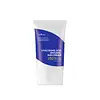What's inside
What's inside
 Key Ingredients
Key Ingredients

 Benefits
Benefits

 Concerns
Concerns

 Ingredients Side-by-side
Ingredients Side-by-side

Water
Skin ConditioningZinc Oxide
Cosmetic ColorantButyloctyl Salicylate
Skin ConditioningPropylheptyl Caprylate
EmollientButylene Glycol
HumectantIsododecane
EmollientC15-19 Alkane
SolventDisiloxane
Skin ConditioningCetyl Diglyceryl Tris(Trimethylsiloxy)Silylethyl Dimethicone
Emulsion StabilisingCaprylyl Methicone
Skin ConditioningSodium Chloride
MaskingTriethylhexanoin
MaskingSodium Hyaluronate
HumectantGlycerin
HumectantMethyl Methacrylate Crosspolymer
Disteardimonium Hectorite
StabilisingTriethoxycaprylylsilane
Polymethylsilsesquioxane
1,2-Hexanediol
Skin ConditioningLauryl Polyglyceryl-3 Polydimethylsiloxyethyl Dimethicone
Skin ConditioningPolyglyceryl-2 Dipolyhydroxystearate
Skin ConditioningLauryl Dimethicone/Polyglycerin-3 Crosspolymer
CleansingCaprylyl Glycol
EmollientGlyceryl Caprylate
EmollientDipropylene Glycol
HumectantTocopherol
AntioxidantSodium Citrate
BufferingBetaine
HumectantInositol
HumectantPanthenol
Skin ConditioningWater, Zinc Oxide, Butyloctyl Salicylate, Propylheptyl Caprylate, Butylene Glycol, Isododecane, C15-19 Alkane, Disiloxane, Cetyl Diglyceryl Tris(Trimethylsiloxy)Silylethyl Dimethicone, Caprylyl Methicone, Sodium Chloride, Triethylhexanoin, Sodium Hyaluronate, Glycerin, Methyl Methacrylate Crosspolymer, Disteardimonium Hectorite, Triethoxycaprylylsilane, Polymethylsilsesquioxane, 1,2-Hexanediol, Lauryl Polyglyceryl-3 Polydimethylsiloxyethyl Dimethicone, Polyglyceryl-2 Dipolyhydroxystearate, Lauryl Dimethicone/Polyglycerin-3 Crosspolymer, Caprylyl Glycol, Glyceryl Caprylate, Dipropylene Glycol, Tocopherol, Sodium Citrate, Betaine, Inositol, Panthenol
Water
Skin ConditioningHexyl Laurate
EmollientGlycerin
HumectantPentylene Glycol
Skin ConditioningOctyldodecanol
EmollientSqualane
EmollientTamarindus Indica Seed Gum
Emulsion StabilisingJasminum Sambac Leaf Cell Extract
MaskingMangostin
Skin ConditioningAcetyl Tetrapeptide-2
Skin ConditioningSodium Hyaluronate
HumectantTocopherol
AntioxidantAlcaligenes Polysaccharides
EmollientDisteardimonium Hectorite
StabilisingAmodimethicone
Carbomer
Emulsion StabilisingMagnesium Chloride
Trisodium Ethylenediamine Disuccinate
Sodium Lauroyl Glutamate
Helianthus Annuus Seed Oil
EmollientPropylene Carbonate
SolventAluminum Hydroxide
EmollientGlucose
HumectantLysine
Skin ConditioningCaprylyl Glycol
EmollientBenzyl Alcohol
PerfumingSodium Hydroxide
BufferingCitric Acid
BufferingMica
Cosmetic ColorantCI 77891
Cosmetic ColorantIron Oxides
Water, Hexyl Laurate, Glycerin, Pentylene Glycol, Octyldodecanol, Squalane, Tamarindus Indica Seed Gum, Jasminum Sambac Leaf Cell Extract, Mangostin, Acetyl Tetrapeptide-2, Sodium Hyaluronate, Tocopherol, Alcaligenes Polysaccharides, Disteardimonium Hectorite, Amodimethicone, Carbomer, Magnesium Chloride, Trisodium Ethylenediamine Disuccinate, Sodium Lauroyl Glutamate, Helianthus Annuus Seed Oil, Propylene Carbonate, Aluminum Hydroxide, Glucose, Lysine, Caprylyl Glycol, Benzyl Alcohol, Sodium Hydroxide, Citric Acid, Mica, CI 77891, Iron Oxides
 Reviews
Reviews

Ingredients Explained
These ingredients are found in both products.
Ingredients higher up in an ingredient list are typically present in a larger amount.
Caprylyl Glycol is a humectant and emollient, meaning it attracts and preserves moisture.
It is a common ingredient in many products, especially those designed to hydrate skin. The primary benefits are retaining moisture, skin softening, and promoting a healthy skin barrier.
Though Caprylyl Glycol is an alcohol derived from fatty acids, it is not the kind that can dry out skin.
This ingredient is also used as a preservative to extend the life of products. It has slight antimicrobial properties.
Learn more about Caprylyl GlycolDisteardimonium Hectorite comes from the clay mineral named hectorite. It is used to add thickness to a product.
It can also help stabilize a product by helping to disperse other ingredients.
Hectorite is a rare, white clay mineral.
Learn more about Disteardimonium HectoriteGlycerin is already naturally found in your skin. It helps moisturize and protect your skin.
A study from 2016 found glycerin to be more effective as a humectant than AHAs and hyaluronic acid.
As a humectant, it helps the skin stay hydrated by pulling moisture to your skin. The low molecular weight of glycerin allows it to pull moisture into the deeper layers of your skin.
Hydrated skin improves your skin barrier; Your skin barrier helps protect against irritants and bacteria.
Glycerin has also been found to have antimicrobial and antiviral properties. Due to these properties, glycerin is often used in wound and burn treatments.
In cosmetics, glycerin is usually derived from plants such as soybean or palm. However, it can also be sourced from animals, such as tallow or animal fat.
This ingredient is organic, colorless, odorless, and non-toxic.
Glycerin is the name for this ingredient in American English. British English uses Glycerol/Glycerine.
Learn more about GlycerinSodium Hyaluronate is hyaluronic acid's salt form. It is commonly derived from the sodium salt of hyaluronic acid.
Like hyaluronic acid, it is great at holding water and acts as a humectant. This makes it a great skin hydrating ingredient.
Sodium Hyaluronate is naturally occurring in our bodies and is mostly found in eye fluid and joints.
These are some other common types of Hyaluronic Acid:
Learn more about Sodium HyaluronateTocopherol (also known as Vitamin E) is a common antioxidant used to help protect the skin from free-radicals and strengthen the skin barrier. It's also fat soluble - this means our skin is great at absorbing it.
Vitamin E also helps keep your natural skin lipids healthy. Your lipid skin barrier naturally consists of lipids, ceramides, and fatty acids. Vitamin E offers extra protection for your skin’s lipid barrier, keeping your skin healthy and nourished.
Another benefit is a bit of UV protection. Vitamin E helps reduce the damage caused by UVB rays. (It should not replace your sunscreen). Combining it with Vitamin C can decrease sunburned cells and hyperpigmentation after UV exposure.
You might have noticed Vitamin E + C often paired together. This is because it is great at stabilizing Vitamin C. Using the two together helps increase the effectiveness of both ingredients.
There are often claims that Vitamin E can reduce/prevent scarring, but these claims haven't been confirmed by scientific research.
Learn more about TocopherolWater. It's the most common cosmetic ingredient of all. You'll usually see it at the top of ingredient lists, meaning that it makes up the largest part of the product.
So why is it so popular? Water most often acts as a solvent - this means that it helps dissolve other ingredients into the formulation.
You'll also recognize water as that liquid we all need to stay alive. If you see this, drink a glass of water. Stay hydrated!
Learn more about Water